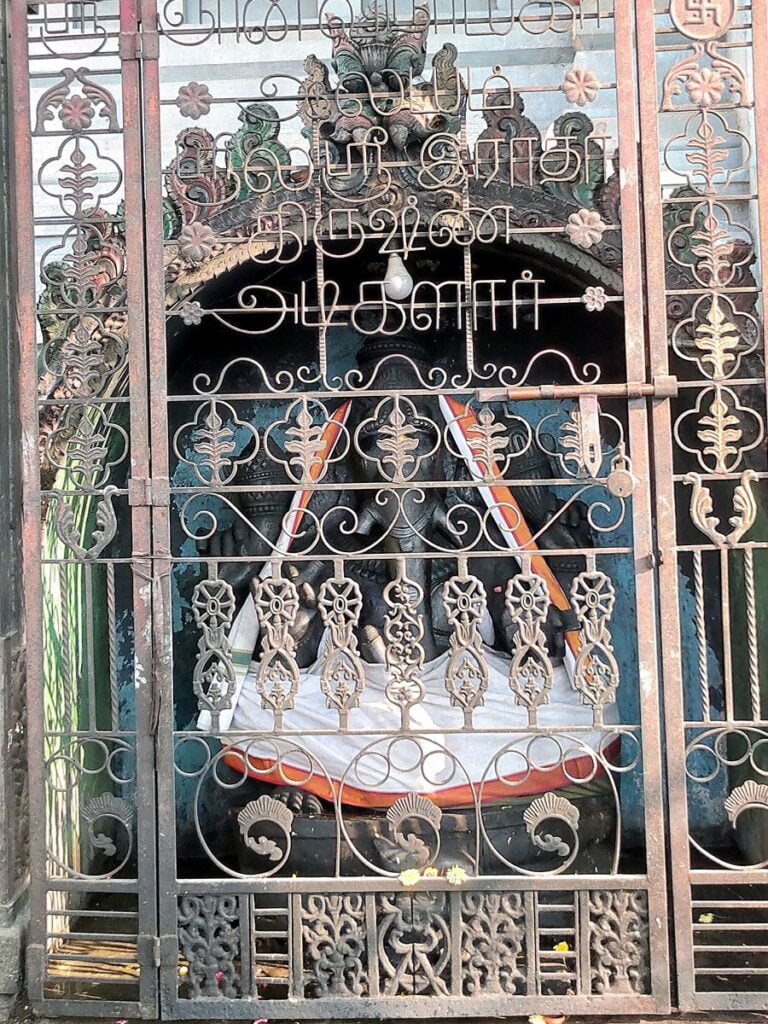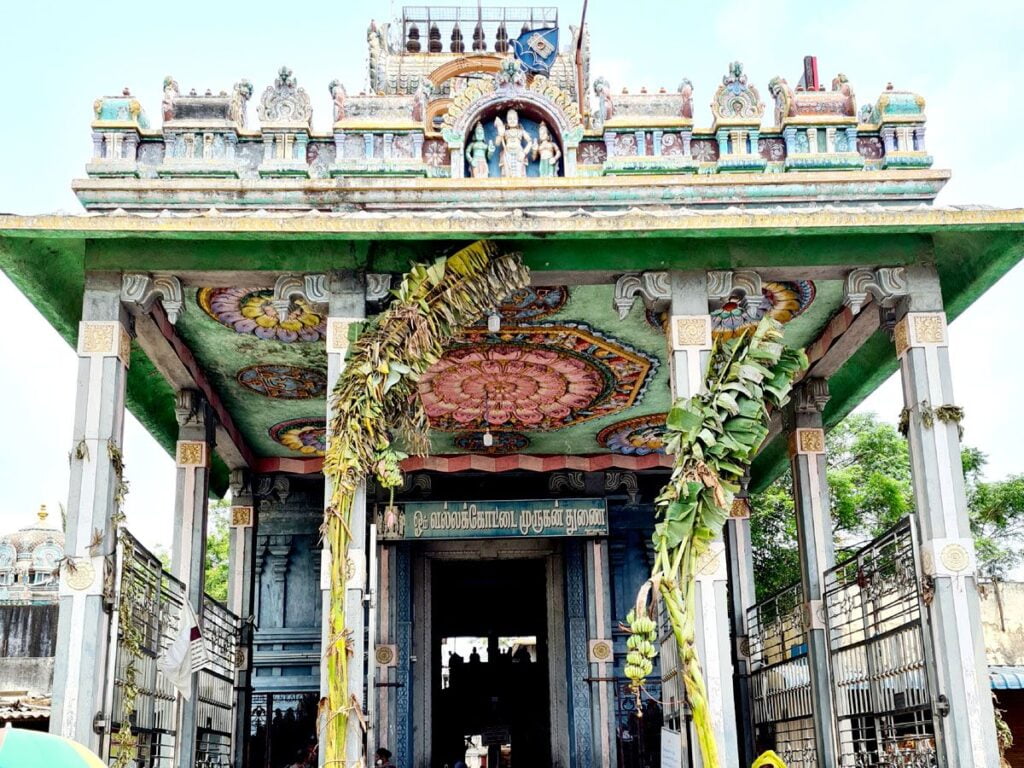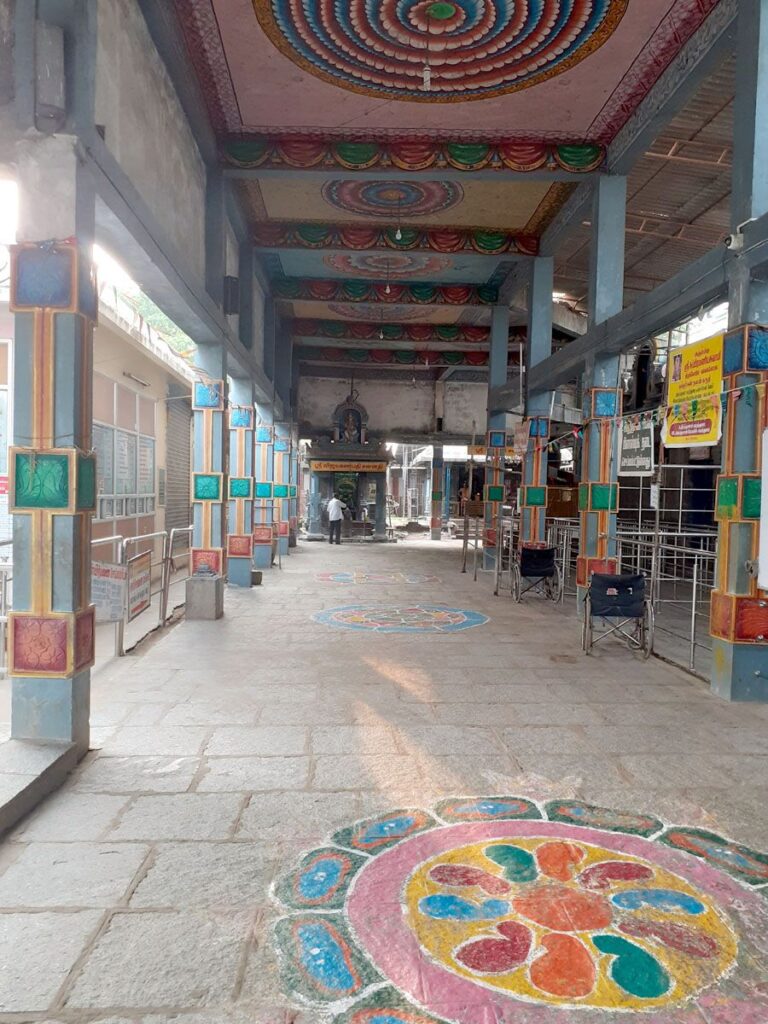Vallakottai Murugan Temple
Vallakottai Murugan Temple is a Hindu temple dedicated to the god Murugan, located in Vallakottai, a panchayat town in Kanchipuram district in the South Indian state of Tamil Nadu. The temple is constructed in the Dravidian style of architecture, and is located in the Sriperumbudur – Singaperumalkoil road.

Contents
- 1 History of Vallakottai Murugan Temple:
- 2 Legend of Vallakottai Murugan Temple:
- 3 Significance of Vallakottai Murugan Temple:
- 4 Architecture of Vallakottai Murugan Temple:
- 5 Myths of Vallakottai Murugan Temple:
- 6 Vallakottai Murugan Temple Timing, Rituals & Festivals:
- 7 Places to visit near Vallakottai Murugan Temple:
- 8 FAQ:
- 8.0.1 1. Where is the Vallakottai Murugan Temple located?
- 8.0.2 2. When was the Vallakottai Murugan Temple built?
- 8.0.3 3. What is the significance of the Vallakottai Murugan Temple?
- 8.0.4 4. What is the architecture of the Vallakottai Murugan Temple?
- 8.0.5 5. What are the main features of the Vallakottai Murugan Temple?
- 8.0.6 6. What are the important festivals celebrated at the Vallakottai Murugan Temple?
- 8.0.7 7. What are the timings of the Vallakottai Murugan Temple?
- 8.0.8 8. How can I reach the Vallakottai Murugan Temple?
- 8.0.9 9. Are there any facilities available for tourists at the Vallakottai Murugan Temple?
- 8.0.10 10. Is there anything else I should know before visiting the Vallakottai Murugan Temple?
- 9 How to reach Vallakottai Murugan Temple:
- 10 Google Maps:
History of Vallakottai Murugan Temple:
The temple is believed to have been built by King Bhagirath, the ruler of Sankondpuram in the kingdom of Ilanji. Bhagirath was a devout devotee of Murugan, and he built the temple to express his gratitude to the god. The temple is dedicated to Murugan in his form as Kodaya Andavar, which means “the one who restores all that is lost.”
The temple is a beautiful example of Dravidian architecture. The main temple complex is enclosed by a five-tiered rajagopuram, or gateway tower. The sanctum sanctorum houses a 7-foot-tall (2.1 m) image of Murugan in a standing posture. There are also images of Murugan’s consorts, Valli and Deivanai, in the sanctum sanctorum.
The temple is also home to a number of other shrines, including shrines dedicated to Ganesha, Vishnu, and Shiva. The temple also has a number of other religious structures, including a mandapa, or hall, where devotees can gather to worship.
Read More>> Uthirakosamangai Temple

Legend of Vallakottai Murugan Temple:
The legend of the Vallakottai Murugan Temple tells the story of a demon named Vallan who was terrorizing the Devas, the celestial deities. The Devas sought the help of Murugan to defeat Vallan. Murugan agreed to help and waged a war against Vallan. After a fierce battle, Murugan was victorious and killed Vallan.
Murugan then established the temple at Vallakottai to commemorate his victory over Vallan. The temple is also known as the “Vallan Kottai,” which means “Vallan’s Fort.”
The temple is built in the Dravidian style of architecture and features a number of sculptures and carvings depicting scenes from the Hindu epics. The main deity of the temple is Murugan, who is depicted in his six-faced form. The temple also houses shrines dedicated to other Hindu deities, including Ganesha, Shiva, and Vishnu.
The Vallakottai Murugan Temple is a popular pilgrimage destination for Hindus from all over India. The temple is especially crowded during the annual Adi Pooram festival, which is celebrated in the month of July or August.
Read More>> Antarvedi Lakshmi Narasimha Swamy Temple

Significance of Vallakottai Murugan Temple:
Mythological Importance:
- Slaying of Vallan: Legend has it that the demon Vallan terrorized the Devas (celestial beings). Lord Murugan, the warrior god, emerged victorious after a fierce battle, slaying Vallan at this very spot. Hence, the place was named Vallakottai (meaning “Fort of Vallan”).
- Indra’s Worship: Indra, the King of Devas, sought guidance from his Guru Brihaspathi on where to worship Murugan. He was directed to Vallakottai, recognizing its importance as a Murugan abode. Indra created the temple tank, Vajra Theertha, using his weapon Vajrayudha, further adding to the temple’s sanctity.
Religious Significance:
- Equal to Arupadaiveedu: The temple finds its mention in the renowned Thirupugazh, a collection of devotional poems by the 15th-century saint Arunagirinathar. Eight verses in the Thirupugazh praise the temple, placing it in importance equal to the six abodes of Murugan (Arupadaiveedu).
- Divine Intervention: Legend narrates that Arunagirinathar, on his way to another Murugan temple, received a divine command in his sleep to visit Vallakottai. This reinforces the temple’s spiritual significance and Murugan’s presence there.
Architectural and Historical Value:
- Ancient Temple: Believed to be around 1,200 years old, the temple was built by King Bhagirath, showcasing Dravidian architectural elements.
- Tallest Murugan Statue: The temple houses the tallest Lord Muruga statue in India, adding to its visual grandeur and attracting devotees seeking blessings.
Devotional Importance:
- Fulfilling Wishes: Devotees believe that praying to Lord Murugan at Vallakottai grants wishes and brings prosperity. It’s especially known for fulfilling prayers related to education, career, and health.
- Special Days: Fridays and Saturdays witness increased footfall as Lord Murugan is believed to be particularly benevolent on these days. The temple celebrates various festivals throughout the year, attracting large crowds with vibrant processions and rituals.
Read More>> Matsya Narayana Temple Chennai

Architecture of Vallakottai Murugan Temple:
Entrance and Gopuram:
- A five-tiered Rajagopuram, the gateway tower, stands tall, adorned with intricate carvings depicting deities and mythical figures.
- A pillared porch, known as mandapam, precedes the Rajagopuram, offering a shaded space for devotees.
Main Hall and Sanctum:
- The main hall, with elaborately carved granite pillars, leads to the sanctum sanctorum.
- The sanctum faces east, housing the 7-feet tall standing idol of the presiding deity, Lord Murugan.
- Twin peacock statues, Murugan’s divine vehicle, flank the main deity.
Other Notable Elements:
- The temple walls showcase vibrant murals depicting scenes from Hindu mythology.
- Decorative stucco work adds texture and depth to the temple’s exteriors.
- Sculptures of other deities and mythical creatures embellish the temple grounds.
Here are some additional details that might be interesting:
- The temple is believed to have been built around the 9th century.
- It is considered one of the six abodes of Lord Murugan, holding significance for devotees.
- The temple complex also includes shrines dedicated to Lord Ganesha, Goddess Valli, and Goddess Deivanai.
- The Adi Pooram festival, held in July-August, draws large crowds to the temple for vibrant processions and celebrations.
Read More>> Kundrathur Murugan Temple Chennai

Myths of Vallakottai Murugan Temple:
The Slaying of the Demon Vallan:
- According to the most popular legend, a powerful demon named Vallan wreaked havoc upon the celestial deities known as the Devas. Desperate for help, they approached Lord Murugan, the Hindu god of war and victory.
- Recognizing the urgency of the situation, Murugan engaged in a fierce battle with Vallan. After a valiant struggle, he emerged victorious, slaying the demon and liberating the Devas from his tyranny.
- The site of this epic battle is believed to be where the Vallakottai Murugan Temple now stands. The name “Vallakottai” itself translates to “Vallan’s fort,” signifying the location’s connection to the myth.
King Bhagiratha’s Redemption:
- Another legend tells the story of King Bhagiratha, a ruler who faced misfortune and lost a battle against his enemies. Dejected and seeking guidance, he consulted the wise sage Narada.
- Narada advised Bhagiratha to seek redemption by worshipping Lord Murugan at the Vallakottai temple. The king diligently followed this advice, offering his prayers and devotion for several years.
- Pleased by Bhagiratha’s dedication, Lord Murugan granted him victory and restored his kingdom’s prosperity. This legend highlights the temple’s association with divine blessings and the power of fervent devotion.
Read More>> Nambunayaki Amman Temple Rameswaram
Vallakottai Murugan Temple Timing, Rituals & Festivals:
Temple Timings:
The temple is generally open for darshan (viewing the deity) from 6:30 AM to 12:00 PM and 5:00 PM to 8:30 PM on all days. However, timings may vary slightly during special occasions and festivals. It’s always recommended to check the temple’s official website or contact the temple administration for the latest timings.
Rituals:
The temple priests perform various poojas (rituals) throughout the day, offering prayers and blessings to the deities. Some of the main rituals include:
- Gho Pooja: Performed at 6:30 AM, marking the opening of the temple.
- Kalasandhi: Performed at 8:00 AM, involving abhishekam (sacred bath) for the deities.
- Uchikala poojai: Performed at 12:00 PM, coinciding with noon.
- Sayarakshai: Performed at 6:00 PM, seeking divine protection for the evening.
- Arthajama Pooja: Performed at 8:15 PM, concluding the day’s rituals.
These rituals involve traditional steps like alangaram (decoration of the deities), neivethanam (offering of food), and deepa aradanai (waving of lamps). Devotees can participate in these rituals by offering prayers, flowers, or fruits.
Festivals:
The Vallakottai Murugan Temple celebrates several festivals throughout the year, attracting large crowds of devotees. Some of the major festivals include:
- Panguni Uthiram: Celebrated in March, commemorating the birth of Lord Murugan.
- Aadi Krithigai: Celebrated in the Tamil month of Aadi (July-August), featuring special abhishekams and processions.
- Brahmotsavam: A ten-day festival celebrated in April-May, with colorful processions and cultural programs.
- Skanda Shashti: A six-day festival celebrated in October-November, marking the victory of Lord Murugan over the demon Tarakasura.
- Thirukarthigai: Celebrated in the month of November-December, dedicated to Lord Murugan’s worship with lamps.
Read More>> Thirumanancheri Temple | Kalyanasundareswarar Temple
Places to visit near Vallakottai Murugan Temple:
- Chennai (Approximately 40 kilometers away):
- Explore the vibrant city of Chennai, which offers a mix of historical, cultural, and modern attractions. Some notable places include Marina Beach, Kapaleeshwarar Temple, Fort St. George, and the Government Museum.
- Mahabalipuram (Approximately 70 kilometers away):
- Visit the UNESCO World Heritage Site of Mahabalipuram, known for its ancient rock-cut temples, Shore Temple, and the famous Arjuna’s Penance.
- Kanchipuram (Approximately 75 kilometers away):
- Explore the temple town of Kanchipuram, famous for its numerous temples and silk weaving industry. Kanchipuram is known as the “City of Thousand Temples.”
- Sriperumbudur (Approximately 40 kilometers away):
- Visit Sriperumbudur, the birthplace of Sri Ramanuja, a renowned philosopher and theologian. The Rajiv Gandhi Memorial is also located here.
- Vandalur Zoo (Approximately 25 kilometers away):
- Arignar Anna Zoological Park, commonly known as Vandalur Zoo, is one of the largest zoological parks in Asia. It is a great place for wildlife enthusiasts.
- Muttukadu (Approximately 50 kilometers away):
- Enjoy water sports and activities at Muttukadu, a backwater area located on the East Coast Road (ECR).
- Pulicat Lake (Approximately 80 kilometers away):
- Visit Pulicat Lake, a large brackish water lagoon known for its bird sanctuary. It’s a great spot for birdwatching.
- Vedanthangal Bird Sanctuary (Approximately 90 kilometers away):
- Another excellent birdwatching location, Vedanthangal Bird Sanctuary is one of the oldest in India and is home to a variety of migratory birds.
Read More>> 3000 years Old Poombarai Murugan Temple
FAQ:
1. Where is the Vallakottai Murugan Temple located?
The Vallakottai Murugan Temple is located in Vallakottai, a panchayat town in the Kanchipuram district of Tamil Nadu, India. It’s situated on the Sriperumbudur – Singaperumalkoil road.
2. When was the Vallakottai Murugan Temple built?
The exact date of the temple’s construction is unknown, but it is believed to be centuries old. Some sources suggest it could be as old as the 10th century.
3. What is the significance of the Vallakottai Murugan Temple?
The Vallakottai Murugan Temple is dedicated to the Hindu god Murugan, also known as Karthikeya, the son of Lord Shiva and Parvati. It is considered one of the most important Murugan temples in Tamil Nadu and is revered in eight verses of the Thirupugazh, a collection of devotional hymns composed by the 15th-century Tamil saint Arunagirinathar.
4. What is the architecture of the Vallakottai Murugan Temple?
The temple is built in the Dravidian style of architecture, characterized by its towering gopurams (gateways), intricately carved pillars, and colorful mandapams (halls).
5. What are the main features of the Vallakottai Murugan Temple?
The temple has a beautiful gopuram, a spacious mandapam, and a sanctum sanctorum where the main idol of Lord Murugan is housed. The idol is seven feet tall, making it the tallest Murugan statue in India. There are also shrines dedicated to other deities, such as Valli, Deivaanai, Vinayagar, and Chandikeswarar.
6. What are the important festivals celebrated at the Vallakottai Murugan Temple?
The temple celebrates several festivals throughout the year, with the most prominent being Adi Pooram, which falls in July or August. Other important festivals include Thai Poosam, Skanda Sashti, and Kanda Sasti Kavasam.
7. What are the timings of the Vallakottai Murugan Temple?
The temple is open from 6:30 am to 12:00 pm and 5:00 pm to 8:30 pm.
8. How can I reach the Vallakottai Murugan Temple?
The temple is easily accessible by road from Chennai, Kanchipuram, and other nearby towns. The nearest railway station is at Sriperumbudur, which is about 10 km from the temple.
9. Are there any facilities available for tourists at the Vallakottai Murugan Temple?
There are a few shops and restaurants located near the temple, but there are no accommodation facilities within the temple complex.
10. Is there anything else I should know before visiting the Vallakottai Murugan Temple?
Dress modestly and respectfully when visiting the temple. It is customary to remove your shoes before entering the sanctum sanctorum. You can offer prayers and pujas to the deities, and you can also purchase prasadam (blessed food) from the temple.
How to reach Vallakottai Murugan Temple:
By Air: The nearest airport is Chennai International Airport (MAA), which is well-connected to major cities in India and abroad. From the airport, you can hire a taxi or use other local transportation to reach Vallakottai.
By Train: The nearest railway station is Kanchipuram Railway Station. From there, you can hire a taxi or take a bus to reach Vallakottai.
By Road:
- From Chennai:
- Vallakottai is approximately 70 kilometers from Chennai. You can take the Chennai-Bengaluru Highway (NH48) and then take a right towards Vallakottai.
- From Kanchipuram:
- Vallakottai is around 25 kilometers from Kanchipuram. You can take the Kanchipuram-Vallakottai Road to reach the temple.
- By Bus:
- Buses connect Vallakottai with major cities and towns in Tamil Nadu. You can find buses from Chennai and Kanchipuram to Vallakottai.
